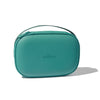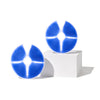From the moment you find out you're pregnant, the Google search bonanza begins. And part of the research journey is—breast pumps. When searching for the best breast pump for you, it can feel overwhelming or even just plain annoying. And what is the difference between all of them always?
We’ve created this guide to help you choose the right type of breast pump to fit your life. Psst, it’s probably a Willow.
How Different Breast Pumps Affect Supply
There are three main types of breast pumps available on the market: manual, electric and wearable or battery-operated. An electric pump uses electricity to power milk expression while a manual pump is more of a hands-on operation. Wearable breast pumps are the newer kid I town but they use battery operated motors to aid in the expression of milk—and they allow more mobility and freedom for moms. We’re a little biased but we think that’s pretty cool.
Manual Breast Pumps
So here’s the low down. If you’re pumping exclusively for your baby, a manual breast pump may negatively impact your milk supply. Double pumping is the best way to yield more milk and unfortunately, manual pumps only pump one breast at a time, which can decrease the amount of milk you produce. However, manual breast pumps are an excellent option to “catch” milk when you’re nursing on one breast or to help in the relief of engorgement.
Electric Breast Pumps
Ah, the ol’ electric breast pump—we meet again. These have been on the market for decades and haven’t changed much. Sure, they do the trick (ie: express milk from both breasts at the same time) and they get the job done. But, they mean mom is tethered to a wall for hours on end and doesn’t get a lot of freedom.
Wearable Breast Pumps
Wearable, in-bra pumps are able to express milk from both breasts at the same time and give mom ultimate mobility and movement. The Willow isn’t like other wearable pumps, though. It not only has been shown to yield 20% more milk for moms,* it also is the only pump out there that works by creating a proprietary continuous suction technology similar to a baby’s latch therefore boosting milk supply.
How Different Breast Pumps Feel
All breast pumps work towards a common goal, so they can all have feel a similar. Yet, there are some small differences between each and it’s up to you to try each one to find the right fit for you.
Manual Breast Pumps
Since you’re working the manual pump yourself, you’ll be able to control the speed and strength of each pump— so you’re in full control of your own comfort.
Electric Breast Pumps
Electric breast pumps provide constant and steady pumping. They also tend to have stronger suction than manual breast pumps or those operated by battery. Typically, these pumps alternate between suction and release, which will feel different than breastfeeding your baby.
Wearable Breast Pumps
Wearable breast pumps also provide constant and steady pumping. Willow may feel different than other pumps on the market as it creates a continuous latch. There is no release until your pumping session is finished.
Willow Tip: In the first few seconds of pumping, it’s normal to feel some discomfort as your nipples stretch, but pumping shouldn’t be painful. If you’re experiencing pain, try reducing the level of suction. If you still feel pain, reach out to your lactation consultant or our team for help.
Are Breast Pumps Loud?
As a mama on-the-go, it’s important to have a pump you feel comfortable using wherever you go. While some breast pumps are loud and clunky, others, like the Willow, are more discreet.
Manual Breast Pumps
Since there isn’t a motor used to express the milk, manual breast pumps are generally quiet. However, it’s possible to hear a squeak as you pump with some models.
Electric Breast Pumps
Electric breast pumps, especially those rated as hospital-grade, tend to be noisy. It’s common to hear the motor whirring as well as sucking sounds as the pumps do their work.
Wearable Breast Pumps
Wearable breast pumps are made for on-the-go use, which means they’re quieter than other electric pumps. Willow is one of the quietest wearable breast pump on the market. Our mamas say they’re able to take a phone call, rock their babies to sleep, or even relax on the couch without worrying about noise.
Electric vs Manual Breast Pump Cleaning
Between the burp rags and the onesies, you already clean up so many messes, mama. Your breast pump shouldn’t require you to perform surgery for proper cleaning.
Manual Breast Pumps
Manual breast pumps can sometimes be hard to clean due to the many parts involved such as the bottle attachments, breast covers, flanges and massager inserts. For the best and safest results, you’ll need to wash all of these parts completely in between uses.
Electric Breast Pumps
Does cleaning multiple sizes and shapes of plastic parts several times a day spark joy? We didn't think so. Manual breast pumps can sometimes be hard to clean due to the many parts involved such as the bottle attachments, breast covers, flanges, tubes and massager inserts. And the CDC recommendselaborate cleaning and sanitization methods after ever pump session for your safety.
Wearable Breast Pumps
Wearable breast pumps are compact for easy portability. Because of this, there are no external tubes or components to clean. Willow is the easiest pump on the market to clean. All you have to worry about is three parts: the flange, FlexTube™ and the milk container (unless you’re using a milk bag).
After every use, you can quickly disassemble the Willow and wash by hand or pop the parts in the dishwasher, top rack only. When you’re ready to pump again, simply snap the pieces back into place and get started.
What Type of Breast Pump Is the Best Option for You?
If you need to express milk occasionally, a manual breast pump may work for you. However, if you’re expressing milk daily and have a busy lifestyle, a wearable breast pump is a great option.
Willow is completely spill-proof and its discreet design allows you to pump when you need to, where you need to. It’s also quiet, provides milk storage options to fit your needs and features suction settings to ensure you’re comfortable as you pump.
Willow 360™ Wearable Breast Pump
Willow 360™ Wearable Breast Pump
Willow 360 is designed with a zero-gravity latch to give you 360° of leak-proof mobility. It's the hands-free breast pump that changed the game.
Willow Go™ Wearable Breast Pump
Willow Go™ Wearable Breast Pump
With hospital-grade suction and a 100% comfort rating, Willow Go pumps quietly and discreetly (no dangling tubes, bottles, or external motors) so you can do it all.




















